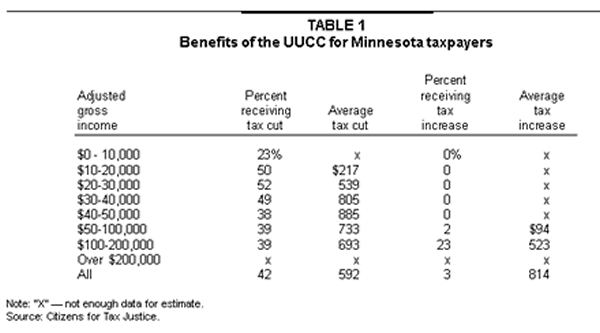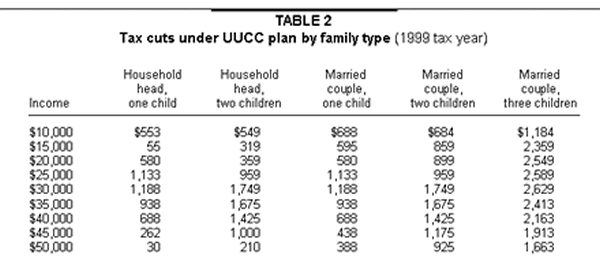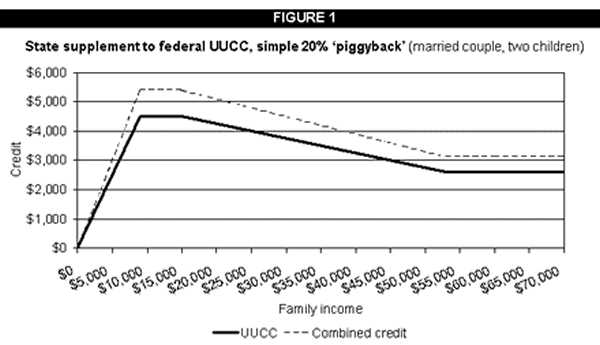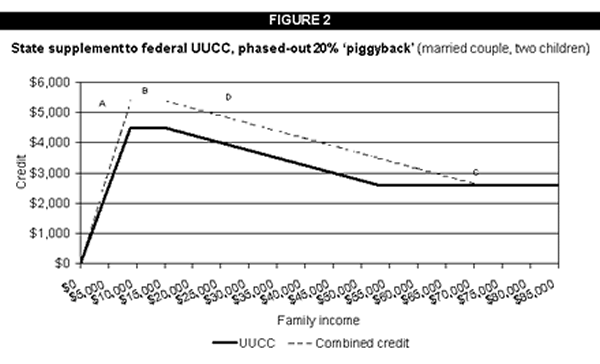Issue Brief #147
Making Minnesota taxes more family friendly
by Max B. Sawicky
With the federal budget projected to run surpluses that accumulate to more than $4.5 trillion over the next 10 years, there has been much talk of cutting taxes but little agreement on how. One possibility that could gain bipartisan support is a tax cut outlined in the report Giving Tax Credit Where Credit Is Due (Cherry and Sawicky 2000), which proposes a merging of the Earned Income Tax Credit (EITC), the dependent exemption, the Child Tax Credit, and the Additional Child Credit. The result would be a simplified single credit for working families with children that we have called the Universal Unified Child Credit (UUCC).
This UUCC proposal could be seriously pursued by both national and state governments. Such a reform can simplify tax systems, improve work incentives, reduce marriage penalties, help poor families distance themselves from the poverty line, and provide middle-class tax relief.
Tax credits and income distribution
Over the past two decades, long periods of stagnant wage growth have led to increases in income inequality for the country as a whole and for almost all states, including Minnesota.1 In fact, it has only been recently that this trend has reversed for workers in the bottom third of the income distribution. A tax credit tied to earnings, such as the UUCC, is one way of directly boosting the incomes of these and other working families in a manner that leaves the tax system simpler, more rewarding of labor force participation and work effort, and more progressive overall.
Although not as dramatic as in other states, Minnesota has experienced a worrisome increase in inequality over the past two decades. Between 1980 and 1998 the average income of the bottom fifth of Minnesota’s population did not change appreciably, while at the same time that of the middle fifth rose by 17%, and the income of the wealthiest fifth increased by over $43,000, or by about 43%. So over a nearly 20-year period, the gap between workers at the bottom and those at the middle and upper ends of the wage scale has grown significantly. Only recently has the bottom fifth of earners seen any real, if small, gains.
While opinions are divided as to whether tax systems should be used to reduce inequality, the overall structure of Minnesota’s tax system is clearly not redistributive. Its state and local taxes are roughly proportional to income (Minnesota Department of Revenue 2000; Minnesota Budget Project 2000), and its progressive state income tax is counter-balanced by regressive taxes on retail sales and various excises.
As an approach to reducing inequality, a proposal like the UUCC has several attractive features. One is that tax-based benefits for children do not increase with income. A second is that working families with no income tax liability get at least as much in benefits for children as higher income families, considering that they pay other taxes, particularly the payroll tax. A third appealing feature is that tax changes that facilitate the transition from welfare to work, as the UUCC does, deserve additional resources. In all of these regards, the UUCC is a relevant reform of the current federal tax system.
Minnesota’s own Working Family Tax Credit (WFTC) reflects the same concerns that the UUCC proposal attempts to address, with the 1998 changes in the WFTC obviously designed to alleviate the marginal tax disincentives that result from the EITC and other programs (Madden 1999; Wilson and Cline 1994; Wilson 2000).
Prior to 1998, the WFTC was a simple percentage of the federal EITC. While this would increase the after-tax incomes of those workers eligible for the credit, it also implied a higher marginal tax rate on additional work effort. For poor families, the WFTC added 15 cents to every dollar of EITC benefit. As income rises, EITC benefits eventually begin to decrease. For every dollar decrease, WFTC benefits went down by 15 cents. Thus if a family in the phase-out range earned five extra dollars, it lost a dollar of EITC benefits and 15 cents of WFTC benefits. Together with the federal income tax, payroll tax, and state income tax, this could push combined marginal tax rates well above 50%.
In 1998 the state legislature changed the structure of the WFTC to alleviate the combined phase-out effect for some families, an objective shared by the UUCC proposal.
Effects of a UUCC on Minnesota families
In 1998 over 200,000 families in Minnesota received EITC and WFTC benefits, for an average combined benefit of $1,570. As noted above, the UUCC would expand the federal contribution to such benefits. The state would have the option of maintaining its current commitment of resources for the credit or finding some other use for the money.
Table 1 provides estimates of the effects of the UUCC proposal based on the adjusted gross income of Minnesota taxpayers. (Note, however, that the estimates in this table are only approximate – federal legislation already in preparation has evolved from the original UUCC proposal used here.) The table shows that the average cut for Minnesota families under the UUCC proposal is almost $600. The largest average cuts are for families earning $30-50,000, reflecting the UUCC’s focus on both alleviating the phase-out effects of the EITC and helping lower-middle-class families. The additional benefit for families in the $10,000 to $20,000 range is about $200.

A small portion of Minnesota’s highest-income taxpayers (about 3%) would see their tax burden increase because the proposal lowers the ‘entry points’ for the 31%, 36%, and 39.6% tax brackets. The purpose of this tax increase is to offset the tax cuts for families with children in these same tax brackets. We cut taxes for the latter families because we eliminate the phase-outs under current law of the dependent exemption and child credit, and we allow eligibility for the UUCC. The rationale for these changes is twofold: to enhance simplicity and equity. The current phase-out of tax benefits for high-income families with children means that two families with equal income but different numbers of children could pay the same tax. We want taxes to reflect ability to pay, and the cost of raising children clearly reduces the ability of one such family to pay relative to another with fewer or no children.
From a poverty standpoint, however, a shortcoming of the UUCC proposal is that it does little for very low-income families who are unable to secure and retain employment. A family needs at least one person with a full-time, minimum wage job to get the maximum UUCC benefits.
Representative families
Since the results in Table 1 are based on averages over a broad number of taxpayers, it is also useful to consider the benefits of the UUCC for specific family types, as shown in Table 2.2 The amounts shown are the differences in taxes under current law compared to those to be had under the version of the UUCC currently being crafted as federal legislation. The benefits could take the form of larger refunds, lower tax liabilities, or some combination of the two.

The general pattern for all the families shown is similar: most of th
e change in benefits is concentrated above the poverty line. As noted above, this is in keeping with the priority on facilitating a working family’s income mobility away from poverty and into the middle class, assuming one or two adults are in full-time employment in the first place.3
We would expect the higher phase-in rate of 50% to encourage entry into the workforce, but for very low wages, the credit remains limited to 50% of an already small amount of earnings. One logical response by a state government to the imposition of a reform like the federal UUCC would be to divert some resources to families that are unable or struggle to participate fully in the labor market.
Augmenting the UUCC on the state level
What sort of changes would a UUCC prompt for state income taxes? A specific consideration of Minnesota’s income tax is beyond the scope of this paper, but some general observations apply.
One option is for a state government to reform its own exemptions, child credits, and earned income credits in the same manner as the UUCC, combining them into one credit. Like the UUCC, such a credit on the state level would phase in for families with no income tax liability and provide cash refunds. If the state adopted the same income milestones (the income levels at which the credit was fully phased in, where it began to phase down, and where it converged to a minimum), the state credit could be a simple percentage of the UUCC.
For example, if the state’s marginal income tax rate is 5%, and its dependent exemption is $2,000 (for a credit value of $100), the state could simply replace its current exemption with one equaling 8% of the UUCC (roughly 100/1300). By this means, no taxpayer would see any tax increases from the elimination of the state’s dependent exemption.
With a simple ‘percentage piggyback,’ as shown in Figure 1, the combined phase-in rate would be higher, since the state is leveraging the federal phase-in with extra dollars. If the federal phase-in is 50% and the state supplement is 20% of the federal credit (up to the maximum), the combined phase-in rate would be 60% – a more powerful incentive to enter the workforce.

An appealing result of this UUCC design is that the phase-down rate need not increase in this approach because neither credit is fully phased-out. For most of the range over which the federal credit phases down, the state credit could remain constant. So the combined phase-down rate is still 5%, the same as the federal rate taken in isolation.
Replacing exemptions with credits and consolidating them with their earned income credits has the same advantages for a state income tax as for the federal tax.4 But if the state chooses to leave its exemptions and child credits untouched, it can supplement the UUCC in other ways. One way would be to adopt the same framework as for the federal UUCC and simply change its parameters to suit its interest in supplementing the UUCC. Then the state UUCC would be calculated simply by subtracting the federal UUCC amount from the amount implied by the state’s expanded schedule (Wilson 2000).
Figure 2 demonstrates what this approach would look like. The solid line is a sample schedule for a federal UUCC credit. The dotted lines suggest possible portions of a supplementary state credit.

The state could elect to leverage the phase-in range by phasing in its own credit with the first dollar of earnings, as in the previous option. With this approach, a state UUCC could allow families to reach the maximum federal benefit level at a lower income level. At that point, it could elect to continue the phase-in to a higher maximum, or stay on the ‘plateau’ for the federal credit (in the figure this is represented by point ‘A,’which has the effect of stretching the plateau to the left).
Alternatively, the state could elect to pick up the federal phase-in where it stops, and continue it to a higher maximum benefit level (point ‘B’). This approach would not require a steeper phase-out, as the figure shows, if the state raises the income level at which its credit phases out to zero (shown in the figure as point ‘C’).
Another option is to extend the plateau to higher income levels (represented by point ‘D’ in the figure). In and of itself, this would not require a more rapid phase-out either.
Conclusion
Expanding the use of refundable tax credits for working families with children makes sense during this time of economic prosperity, budgetary flexibility, and interest in welfare reform. Minnesota has an opportunity to lead the way.
Endnotes
1. See Mishel et al. (2001); Bernstein, McNichol, Mishel, and Zahradnik (2000); and Madden (2000).
2. Table 2 assumes that the family’s entire income is derived from wages and salary, self-employment, or proprietorship (Schedule C income). The interaction of the UUCC with Minnesota’s income tax is not taken into account, since the state credit would need to be modified after a federal reform.
3. The erratic pattern in tax cuts for a household head with one child results from the interaction of the credit with the tax brackets for this type of family.
4. See Cherry and Sawicky (2000) for a thorough discussion of these advantages.
References
Department of Revenue. 1999. “Report on Tax Incidence.” State of Minnesota.
Madden, Nan. 1999. Minnesota: Expansion of state tax credit makes work pay for welfare families. Poverty Research News. Vol. III (Winter), No. 1.
Madden, Nan, Molly Moilanen, and Lisa Jordan. 2000. Making a Living? The State of Working Minnesota. Minnesota Budget Project.
Minnesota Budget Project. 1999. Minnesota Tax Burdens: Who Pays and How Much? An Explanation of Tax Incidence.
Mishel, Lawrence, Jared Bernstein, and John Schmitt. 2001. The State of Working America 2000-01. Ithaca, N.Y.: Cornell University Press.
Wilson, Paul. 2000. “Tax Implications of Welfare Reform: The Minnesota Experience.” Paper presented at the National Tax Association Spring Symposium, Washington, D.C., June.
Wilson, Paul, and Robert Cline. 1994. State Welfare Reform: Integrating Tax Credits and Income Transfers. National Tax Journal. September, pp. 655-76.
